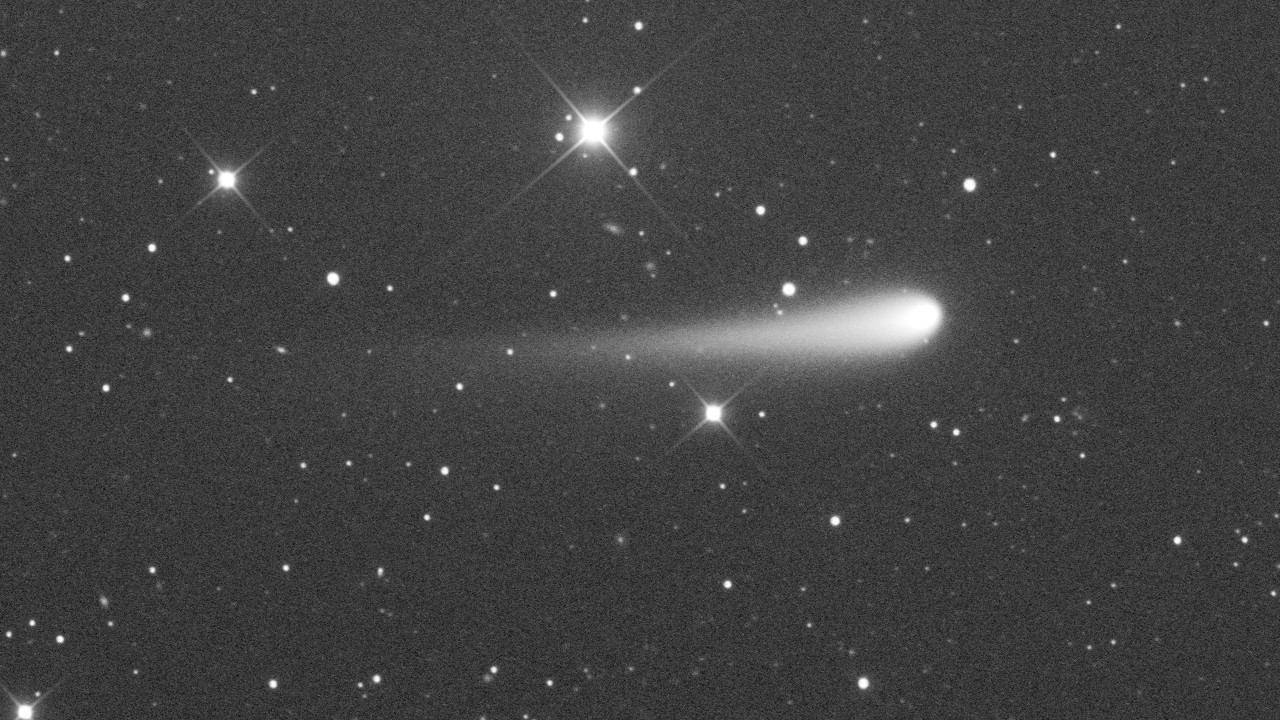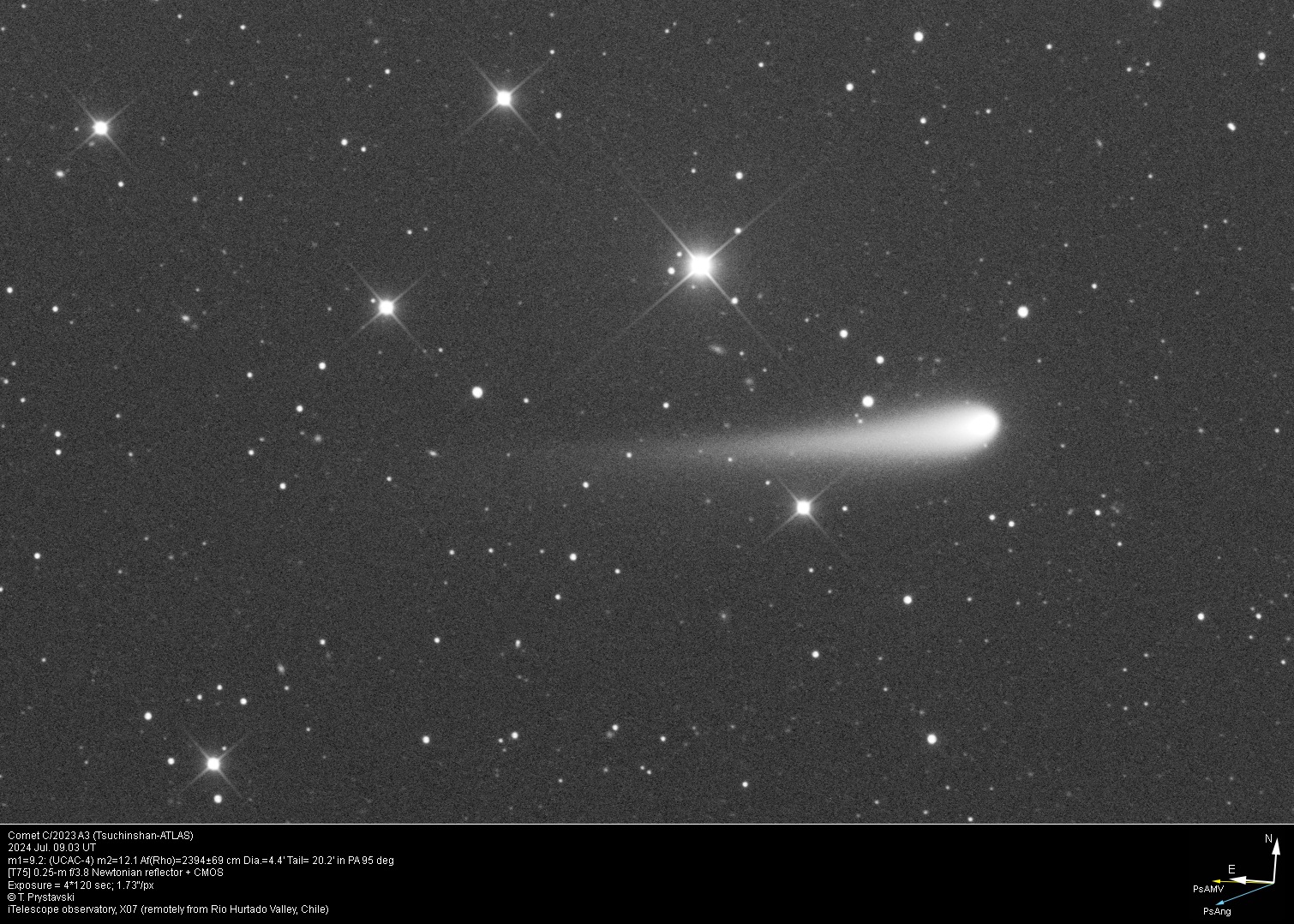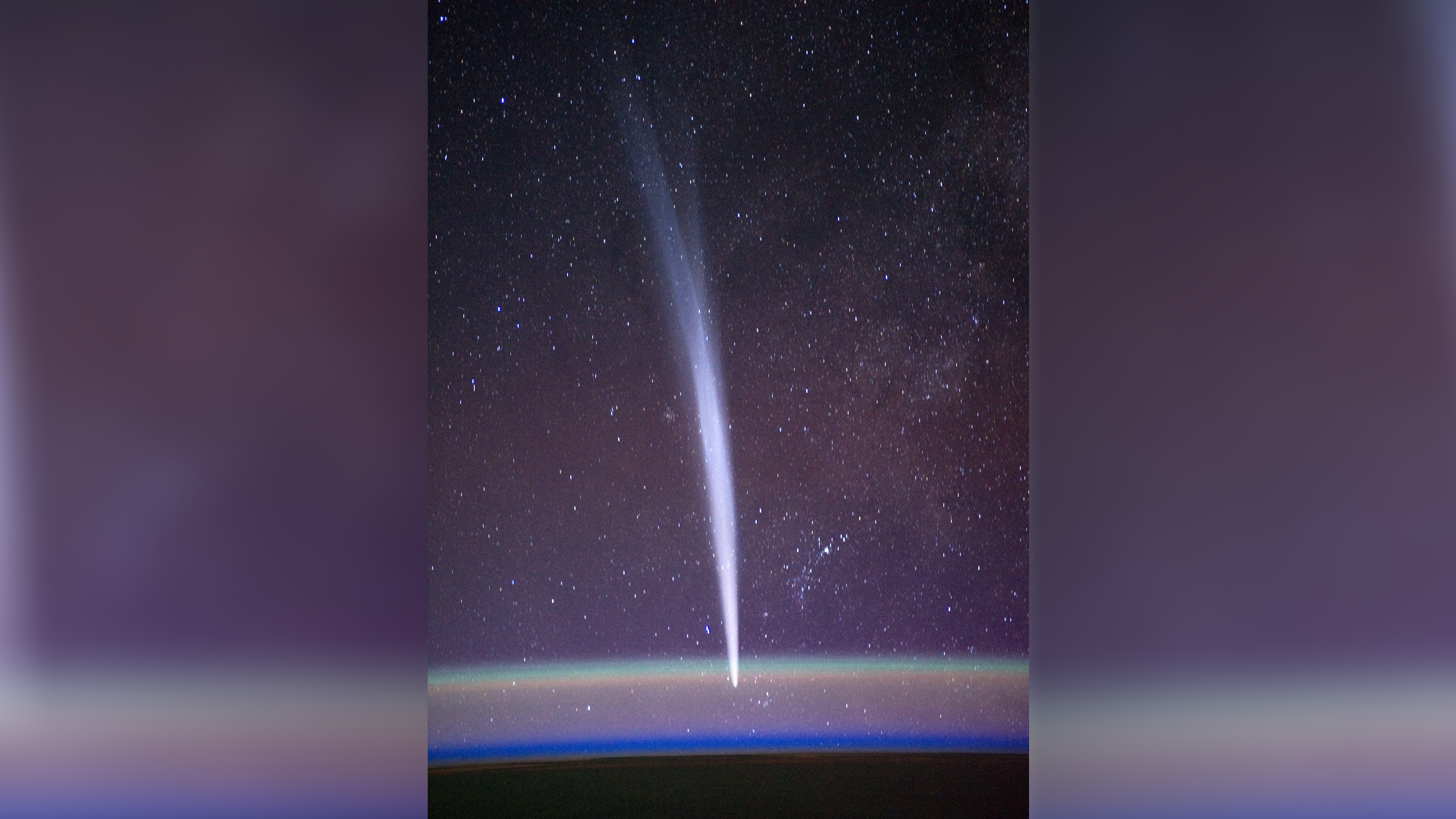
In recent months there has been a gradual build-up of excitement regarding the approach of a new comet with the moniker, Tsuchinshan-ATLAS, cataloged officially as C/2023 A3.
Comet Tsuchinchan-ATLAS (C/2023 A3) was first discovered at the Purple Mountain Observatory's XuYi Station in China on Jan. 9, 2023, then lost and discovered a second time 44 days later at the Asteroid Terrestrial Impact Last Alert System (ATLAS) search project's station at Sutherland, South Africa. Hopes have been running high that this would develop into a bright naked-eye object by the fall of 2024.
But a new technical paper recently released on July 9, by a well-known expert on comets, states that rather than dazzle, comet Tsuchinshan-ATLAS will in all likelihood, fall apart and disintegrate before it has a chance to swing around the sun in late September.
The report comes from Dr. Zdeněk Sekanina, formerly at NASA/JPL, and an expert on split and dissolving comets. In his report, Dr. Sekanina provides three main reasons that he believes that the comet is all but finished:
"The purpose of this paper," writes Dr. Sekanina, "is not to disappoint comet observers who have been looking forward to a new naked eye object this coming October, but to present scientific arguments that do not appear to substantiate such hopes." While openly admitting that predicting the disintegration of a comet prior to it reaching its closest point to the sun (perihelion) is "admittedly a very risky undertaking," Dr. Sekinina feels that "the time has come to go ahead with it."
Comet Tsuchinshan-ATLAS is forecasted to arrive at perihelion on Sept. 27, at a distance of 36 million miles (58 million km) from the sun — a distance equal to that of the average distance of Mercury, the closest planet to our star.
If you want to check out Comet Tsuchinshan–ATLAS this year (if it remains intact!), our guides for the best telescopes and best binoculars are a great place to start. And if you're looking to take stellar photos of the night sky, check out our guides on how to photograph comets, or ones recommending the best cameras for astrophotography and best lenses for astrophotography.
Breaking space news, the latest updates on rocket launches, skywatching events and more!
Who do we believe?

Looking for a telescope to see comets up close? We recommend the Celestron Astro Fi 102 as the top pick in our best beginner's telescope guide.
Because Dr. Sekanina is very well respected in the field, whatever he says carries a lot of weight in astronomical circles. Still, his thoughts concerning the future of the approaching comet have been met with belief and conviction mixed with skepticism and uncertainty.
One person who had high hopes for a great show from Tsuchinshan-ATLAS, but now appears to have changed his mind based on Dr. Sekanina's conclusion is Joseph Marcus, a pathologist with a longtime interest in comets. As a resident at Washington University in St. Louis, he founded and edited the quarterly "Comet News Service" published by the McDonnell Planetarium from 1975 to 1986. In an email to Space.com, Dr. Marcus writes:
"The case that Sekanina litigates is compelling. In the unlikely event C/2023 A3 were to survive to perihelion, it would see an enhancement in brightness of nearly 7 magnitudes." (equal to a ratio of brightness increase of nearly 600-fold). "But," he adds, "It's now a moot point. I am betting on disintegration, as Sekanina now advocates, and to whom I unreservedly defer. Ultimately, the comet will soon be no longer."
But others are not convinced ... yet.
Nick James, director of the Comet Section of the British Astronomical Association, says that while Sekanina's paper is "fascinating," he finds no evidence of non-gravitational accelerations. "This doesn't look like a comet that is fragmenting to me," he says.
Another skeptic is Dr. Clay Sherrod of the Arkansas Sky Observatories at Petit Jean Mountain. "The comet is not going anywhere; it is just fine and not 'fragmenting' in my opinion," he notes.
Looking "healthy"
Echoing Dr. Sherrod and Mr. James, is Taras Prystavski, an amateur astronomer who lives in Lviv, Ukraine who enjoys photographing a variety of celestial objects such as comets. He has provided Space.com with an image of Tsuchinshan-ATLAS rendered on July 9, commenting that: "To me, the comet looks healthy. Some images reveal an ion tail has also appeared, but very faint. I know an ion tail appearance indicates that the comet nucleus is healthy. So, there's a small hope to see a great show in autumn."

Finally, there is Daniel Green at the Central Bureau for Astronomical Telegrams (CBAT), who cautiously writes: "I think that the comet appears healthy, and it is now showing an ion tail, as well. I see no evidence of this comet disintegrating, so all we can do now is wait and see. We'll know by late September (if not a little earlier) if it's going to be a neat comet in October."
Predicting the future is tough!
The late, great baseball sage, Yogi Berra once said: "It's difficult to make predictions, especially about the future." These words certainly ring true about trying to forecast what a new comet might do.
While it is true that comet Tsuchinshan-ATLAS's brightness more-or-less flat-lined from mid-April through the end of June at magnitude +10.5, there are signs that it's brightness (based on the Comet Observation Database/COBS) is slowly beginning to perk-up again during the first half of July.
Telescopes reveal that the comet's dusty head or coma has swelled to a linear diameter of roughly 180,000 miles (290,000 km), while its tail now measures roughly 1 million miles (1.6 million km) in length. Unfortunately, for viewers in the Northern Hemisphere, the comet is now getting too near to the glare of the sun to observe; in the coming weeks only those living south of the equator will be able to observe its future progress.
Currently, the comet is located at a distance of roughly 158 million miles (254 million km) from the sun and is experiencing temperatures of about -150°F (-100°C). It's now beginning to cross the "water line" where frozen gases sublimate into vapor. If it manages to survive all the way to perihelion on Sept. 27 (something that Dr. Sekanina does not expect to happen) it will be subjected to temperatures exceeding 1,000°F (1,600°C).
Hot tea analogy
Now picture this: Here we have a piece of matter likely dating back to the beginning of the solar system, nearly 5 billion years ago, which through all that time has been locked in an unbelievably frigid environment with temperatures hovering close to absolute zero. Yet, in the coming weeks, it will encounter increasingly hot temperatures of many hundreds of degrees.
So, what happens when you pour hot tea into a cold glass?
That's what might happen to comet Tsuchinshan-ATLAS in the coming weeks; it could shatter and fall completely apart.
Not a foregone conclusion
Does this mean, as Dr. Sekanina has titled his paper, that it's an "Inevitable Endgame" for comet Tsuchinshan-ATLAS?
Not necessarily.
In November 2011, Australian amateur astronomer Terry Lovejoy, discovered a very tiny comet, whose nucleus measured only 1,600 feet (500 meters) in diameter and would pass only 87,000 miles (140,000 km) from the surface of the sun. It was not expected to survive and yet somehow it did and briefly put on a very nice show visually for Southern Hemisphere observers (a short time later, after rounding the sun, comet Lovejoy did indeed disintegrate as it headed back out into space).

And in 1996, a comet that was promoted as a "can't miss" spectacular was heading inbound toward the sun and then suddenly and inexplicably ceased brightening all the way from the first week of July until the middle of October. Then suddenly, the comet got back on track and started to brighten, but then just as quickly its brightening ebbed again by mid-November. Some became very concerned that the comet was going to become a flop. But by spring 1997, all fears were assuaged as the comet developed into a beautiful celestial showpiece.
The comet's name? Hale-Bopp.
So, maybe Yogi was right, making predictions about the future is difficult. And perhaps the only thing we can do now, as Daniel Green suggests, is take a "wait and see" attitude regarding what Tsuchinshan-ATLAS will do in the coming days and weeks. It may, as Dr. Sekanina predicts, disintegrate, but at the moment it's still whole and hearty.
And to that end, allow me to invoke a final Yogi-ism:
"It ain't over, till it's over!"
Joe Rao serves as an instructor and guest lecturer at New York's Hayden Planetarium. He writes about astronomy for Natural History magazine, the Farmers' Almanac and other publications.
Join our Space Forums to keep talking space on the latest missions, night sky and more! And if you have a news tip, correction or comment, let us know at: community@space.com.

Joe Rao is Space.com's skywatching columnist, as well as a veteran meteorologist and eclipse chaser who also serves as an instructor and guest lecturer at New York's Hayden Planetarium. He writes about astronomy for Natural History magazine, Sky & Telescope and other publications. Joe is an 8-time Emmy-nominated meteorologist who served the Putnam Valley region of New York for over 21 years. You can find him on Twitter and YouTube tracking lunar and solar eclipses, meteor showers and more. To find out Joe's latest project, visit him on Twitter.
-
Unclear Engineer I would have appreciated some more science in the description of Dr. Sekanina's "three main reasons that he believes that the comet is all but finished." There is a colon after that sentence, but then the story switches to how well respected he is and what others disagree with him about. Was something edited out of the story? Readers seem to have to glean from the disagreements what Dr, Sekanina's data and logic are that support his conclusion.Reply -
JustPassingThrough 08/10/2024 @ 6:30am The 'INTRUDER' (And yes we must treat this as an intruder) appears to be equally level with Earths orbit, while aligning with our Star as well. It's intentions are not apparent/transparent, but seem's as if it is rolling through the wrong hood so to speak. Shoot it down. What ever it is...Reply -
COLGeek Reply
Assuming this is a serious comment (?), just how would you propose doing this?JustPassingThrough said:08/10/2024 @ 6:30am The 'INTRUDER' (And yes we must treat this as an intruder) appears to be equally level with Earths orbit, while aligning with our Star as well. It's intentions are not apparent/transparent, but seem's as if it is rolling through the wrong hood so to speak. Shoot it down. What ever it is...
Shooting down is a bit of a misnomer. Assuming you could disrupt the core, what do you suggest for the all the bits that remain?
